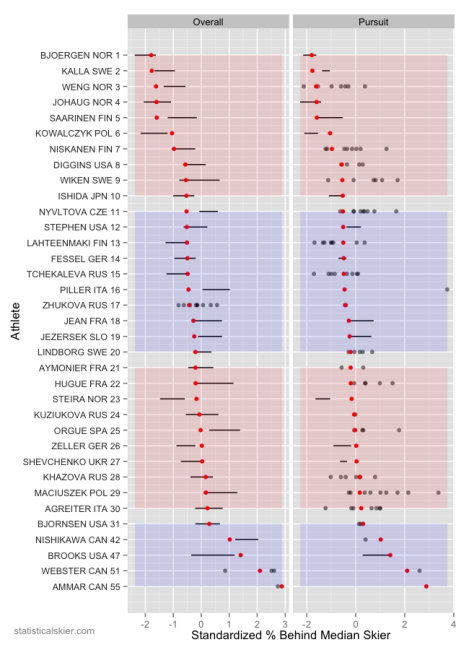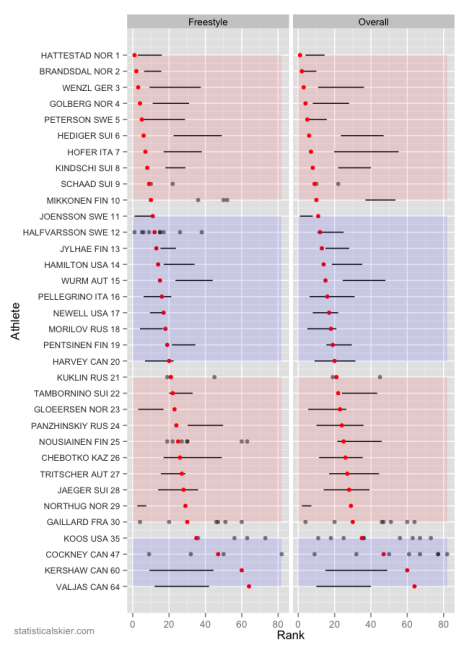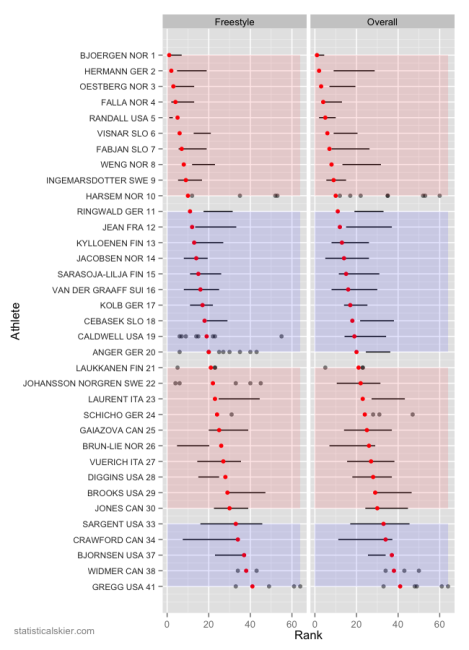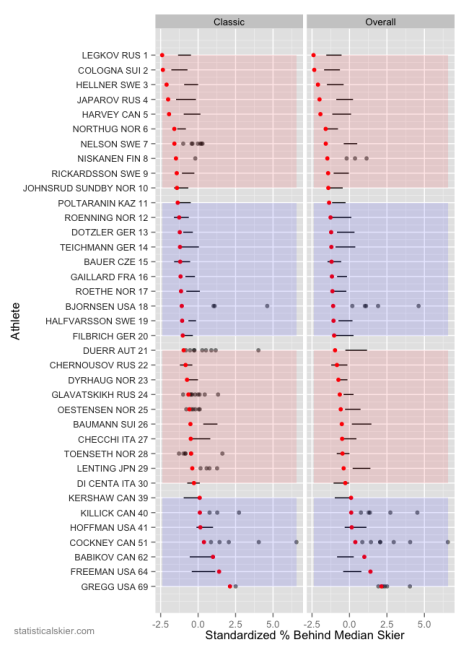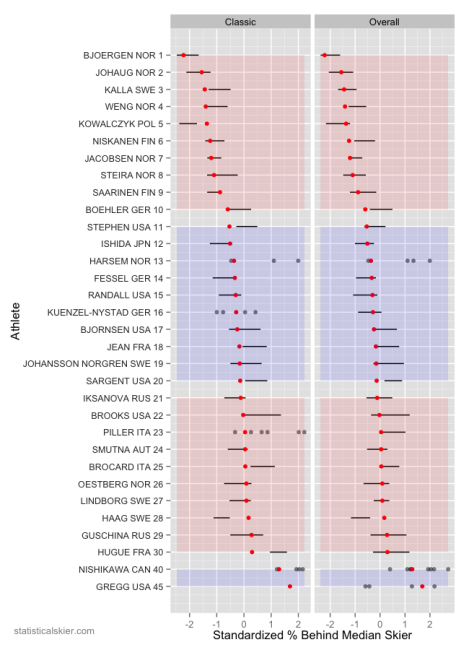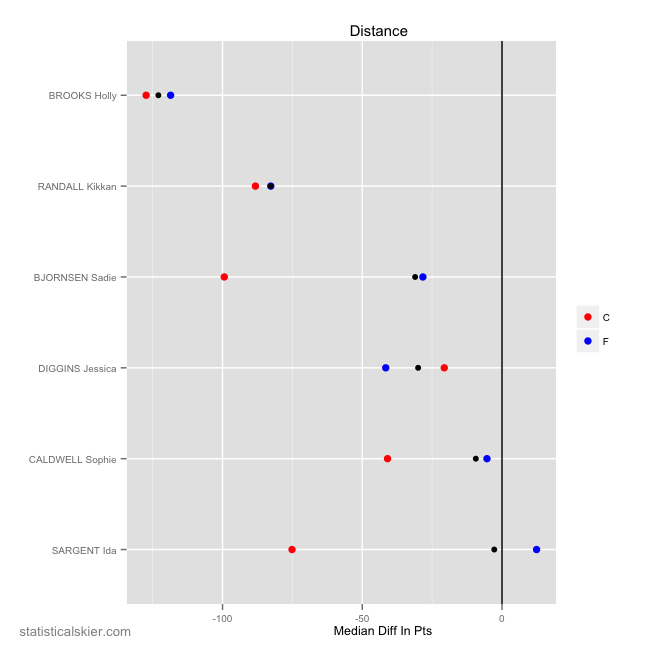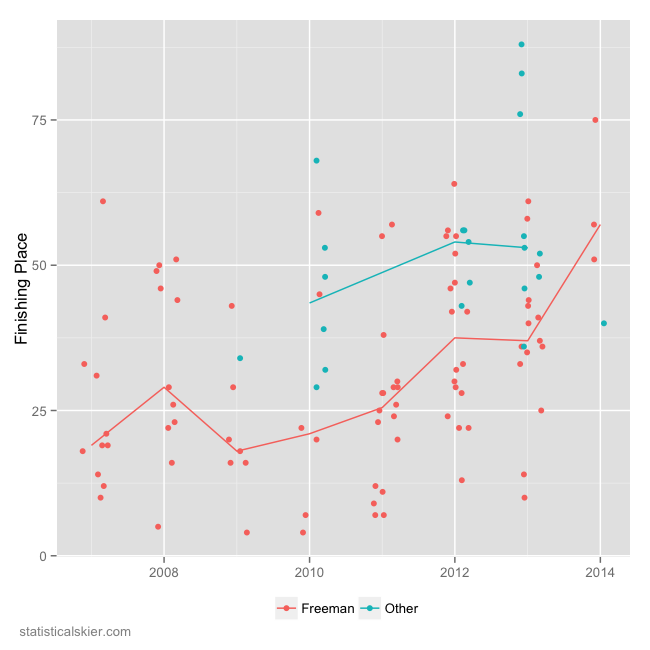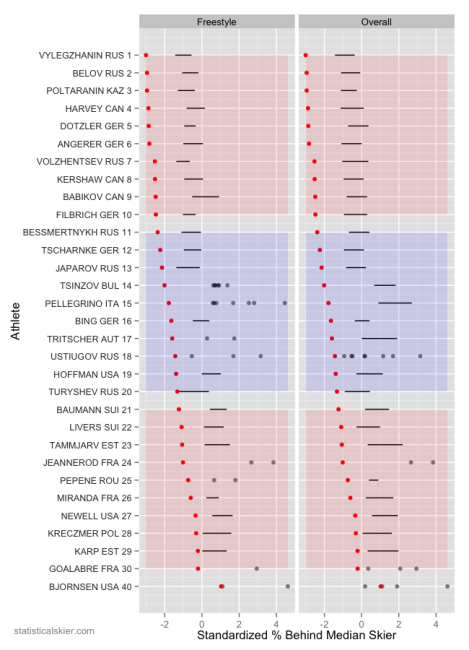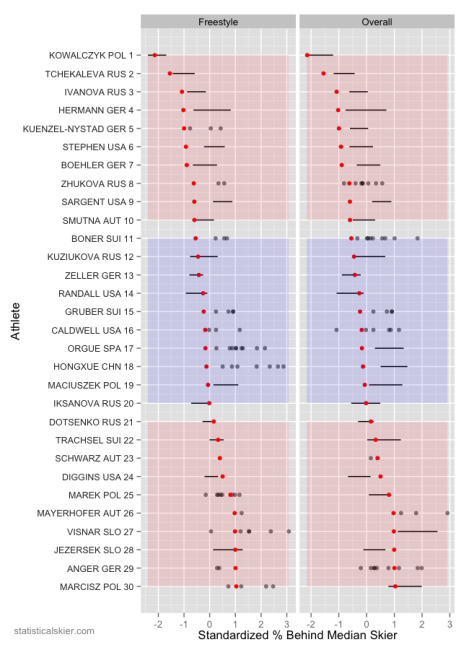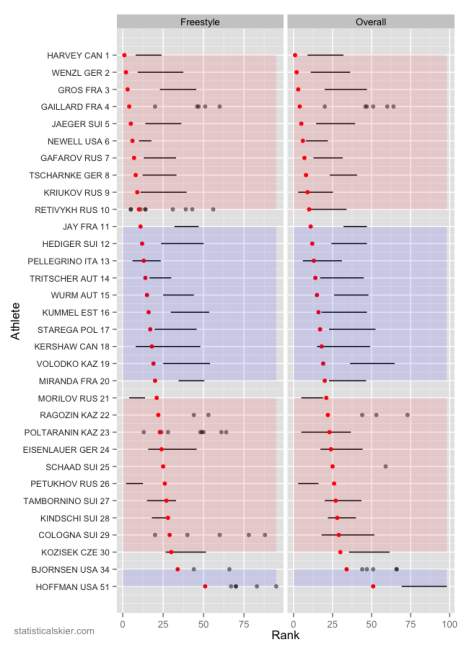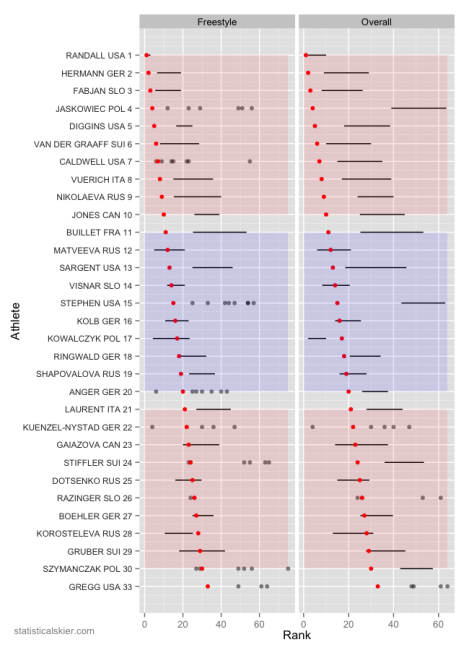Pages
- Merry Christmas! 4 views
- Is Sprinting A Young Person’s Game? 2 views
- Variability In World Cup Ski Racers 2 views
- Race Snapshot: Drammen Freestyle Sprint 1 view
- Diversity of Nations 1 view
- Can Bjørgen Repeat Her Dominant Performance? 1 view
- The USA-CAN Men’s Relay Rivalry Has A Very Long History 1 view
- Animated WJC Results History 1 view
- Daehlie vs. Smirnov 1 view
- Most Improved: Men’s Distance 1 view
Tags
Age Analysis biathlon bump chart canada classic cycling Davos development devon kershaw Distance fis points freestyle giro d'italia kikkan randall kris freeman kuusamo liz stephen marit bjoergen mass start men most improved norway olympics pursuit race snapshot recap retirement retrospective season preview sochi Sprint stage race sweden tour de france tour de ski U23 USA usst wbc week in review WJC/U23 women World Cup WSC
The Caitlin Gregg Situation
Ah, yes, another Olympic year, another wildly entertaining FasterSkier comment thread regarding team selection.
I find this round interesting because I sort of assumed that most of the heat this year would fall on the men’s selections, but apparently the decision to not select Caitlin Gregg is getting the bulk of the attention.
This is a singularly difficult thing to analyze, because there just isn’t much concrete data to go on. But let’s get a few things straight right up front. The selection criteria were clearly intended to not give special preference to people skiing fast just this fall. You really had to have had good points from last season as well, and some of the best opportunities for those points would have come at the spring races with the US women present (mostly).
There’s no question that reasonable people can disagree on whether this is the best strategy for a selection criteria, but I think it’s impossible to argue that its a bad idea, or even the worst idea. At best, you’re only going to see 7-8 starts from someone by early January, and when you consider someone like Gregg who you’d be taking primarily to ski a distance skate race, you really are only going to see 2-3 relevant results out of her in that time period. That’s not a lot to go on, really, and I think it’s perfectly reasonable to ask that a major part of putting yourself on an Olympic team to be demonstrating that you can ski fast over a longer time period, and against relevant fields.
So let’s acknowledge that Caitlin hasn’t raced against anyone on the US team at all this season (except for the two recent sprints in Europe). What do we know about how she has stacked up against that particular group? If we take each head-to-head matchup between Gregg and one of Randall, Diggins, Bjornsen, Brooks, Caldwell and Sargent, Gregg compiled a 6-25 record in 2011-2012 and a 3-20 record in 2012-2013. Not surprisingly, in sprint races its even worse, with a 2-11 record in 2011-2012 and an 0-20 record in 2012-2013. In graphical form, that looks roughly like this:
Negative values are bad for Gregg here. Over the past two season, Holly has basically dominated Gregg overall. Brooks hasn’t skied all that well herself this year, and I think it’s clear that Gregg is skiing faster. Have they moved enough to swap places? Impossible to say, since they haven’t skied against each other yet.
Last season, basically all of those match ups (except against Brooks) came during  “Spring Series” (I’m honestly not sure if they still call it that, but I like the name) at which Gregg skied rather poorly. It’s quite possible that she was just unlucky, getting sick near those races, or maybe she just didn’t manage her fitness as well as she could have and went into the series a little run down. Who knows. Regardless, I feel like anyone looking at the selection criteria would have known that those races were going to be very, very important, both for potential points and for demonstrating an ability to ski toe-to-toe with the gals spending all year over in Europe. So that was clearly a missed opportunity.
So the record we do have from Gregg from 2011 through last spring has very little evidence that she was skiing very close to the level of the top US women in Europe. But then she shows up this fall and has clearly improved, winning or finishing on the podium of basically everything she enters. In particular, she crushed the field in both of the freestyle skate races, a 10k and a 20k mass start. Does that tell us anything meaningful?
It’s hard to say. Normally, I’d be very skeptical of reading much into a huge margin in a mass start race, since the in race dynamics can be so weird. Certainly, a good portion of that margin came from the field simply deciding they weren’t going to catch her and they started racing for second. But she won the 10k individual start in Yellowstone by a huge margin as well. My personal feeling is that while she was clearly the best skier on both days, I have a hard time putting much stock in the margin of victory. The Yellowstone race was an extremely early season event, and the other was a mass start.
And then there’s the problem that you just keep circling back to: the fact that the people she’s beating in those races themselves fare very poorly against the top US women. In those two skate races, the other top women (Patterson, Fitzgerald, Flowers, Brennan, Rorabaugh) all have pretty dismal records against the US Ski Team women themselves. Brennan skied well enough to earn herself a trip to Eurpoe, but even she went 12-40 against that group in 2012-2013 and only 2-18 so far this season.
And finally, two stellar races in the discipline you want her in isn’t much of a trend, really.
I realize as I’m writing this that I probably sound very negative about Gregg’s results this season. Actually, that’s not the case. I think it’s clear that she’s skiing considerably better than last year. I would have loved to have seen her selected and it would have been great to watch her ski in the 30k in Sochi. But the selection criteria made it pretty clear, I think, that relying on skiing fast this fall to get in was going to be long odds. A stronger signal would have been to put up some good results last spring against the other top US women head-to-head and then demonstrate you can sustain it when racing resumes the next fall.
I think it’s perfectly fair for people to react to Gregg’s non-selection with a cry of “What does it take?” The answer to that is complicated by the fact that the Olympics are such an emotionally charged event. The Games have symbolic and cultural importance for many people that really transcends the more mundane aspirations of a national skiing body (winning hardware). It’s frustrating, but I think it’s unfair to expect an organization like USSA,  whose mission really ought to be to do everything it can to win, now and in the future, to treat Olympic starts any differently than World Cup or World Championship starts. Still, as a fan, that can be tough to swallow.
Gregg’s been working a long time for this, she’s well known, and folks look up to her. Sending her to Sochi to race the 30k would certainly have been a big payoff for a lot of long, hard work, even if she isn’t likely to finish very high up the results, and even if, at ~34, she’s not likely to remain an elite racer for that much longer. But it would certainly make a lot of folks back home happy and excited about ski racing.
The counter-argument is that I think the folks running the US Ski Team want us all to dream bigger. The days of simply going to the Olympics, or simply getting the chance to race in Europe as a fitting reward to a long career are over. Qualifying for Olympic/World Champ teams, attaining first period WC start rights, are all just steps along the way. Worth celebrating, for sure, but no longer a career capping moment. I think on some level, they actually don’t want us to be aspiring to long, successful domestic racing careers capped off with a trip to a major event with middling results.
And I think that mostly people are ok with that message, and that we really are dreaming bigger. But when it comes to the Olympic Games, the cold hard reality of that message can really sting, since for so many the Olympics are just a different beast altogether.
I don’t really have an ending for all this, except to say that I’m excited that Caitlin Gregg is skiing so well this year, and that as an American I’m thrilled to see what results she can put up across the pond, Olympics or no.
US Men’s Distance Olympic Selection
One of the hot topics this week in the US is who will be named to the Olympic team. There is particularly heavy speculation surrounding the men’s distance skiers, since that’s the most wide open (and the weakest). There are a lot of factors that go into a decision like this that I’m just going to ignore: having enough racers in case someone gets sick, starting young skiers versus older skiers, etc. Those are all judgement calls.
I’m going to throw a lot of stuff into this post, but my main message here is that there really is no such thing as an “objective criteria”. I’m going to limit myself here to Kris Freeman, Brian Gregg, Matt Liebsch, Sylvan Ellefson, Erik Bjornsen and Miles Havlick. It’s possible that Bjornsen will get in based on his sprint points anyway, but I’m going to include him regardless.
The range in distance FIS points for these six is only 5.31 based on the current list. If you actually included a confidence interval on each person’s FIS points (which are an average, remember) they would encompass a range of 4-7 FIS points for each of them. So statistically speaking, that “objective” measure is essentially indistinguishable.
And of course, it is extremely sensitive to what you might call “researcher degrees of freedom“. FIS points are designed to measure one very specific thing (if you even believe they do a good job of that): how fast could someone ski, if everything goes perfectly? Even if you assume that FIS points “work” they will never measure how fast someone will typically ski. That’s baked into the cake with the decision to average each person’s five best results.
For example, if instead of averaging the best 5 results you took the median of all results over the previous year, they would be in the order Ellefson, Gregg, Liebsch, Havlick, Freeman, Bjornsen. If you take the median of the results just this season, the order would be Ellefson, Gregg, Liebsch, Bjornsen, Freeman, Havlick.
Personally, I’m more partial to using head-to-head data to compare skiers. Then you don’t need to decide whether you “believe” FIS points or not, since we’re just using (essentially) differences in percent back when they actually ski against each other.
So if you take all head-to-head matchups among those six over the past year, weight them by date, and take the median of those results, the order would be Freeman, Bjornsen, Ellefson, Havlick, Gregg and Liebsch. This last measure highlights the degree to which Gregg and Liebsch are getting good points at races that the other folks didn’t happen to be at.
Lastly, are we shuffling deck chairs on the Titanic here? Are any of these guys likely to finish in the top 30 or top 20 in Sochi? (I am not an unfeeling robot; I acknowledge that there are more sentimental reasons to name people, as a reward to excellent domestic performances, regardless of how likely they are to have success internationally.)
The following graph shows the major international distance results for this group of guys over the past several seasons. Since Freeman is responsible for so many of them, I’ve separated him out.
Nothing to write home about for anyone here, so regardless of who is named, my expectations for results are pretty low.
Just for fun, I’ll go ahead and say what I’d do in a fantasy land where I’m not bound by official selection criteria. In addition to the pre-qualified men I would name Kris Freeman, Torin Koos, Erik Bjornsen and Sylvan Ellefson. Why? Well, Freeman hasn’t been skiing well lately, but he’s the only one of the group I think actually could pop a top 10 or top 5 result if the stars aligned. Koos because you just need another sprinter, and he’s the obvious choice. Bjornsen both based on recent performance and the “youth” argument, and Ellefson because he seems to be skiing particularly well this season.
Tagged Analysis, men, olympics, team selection, USA